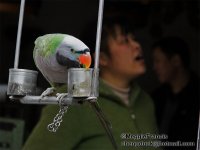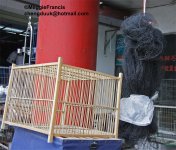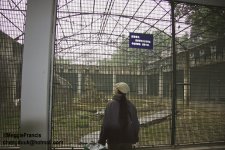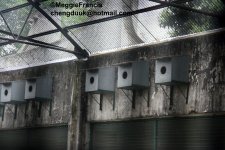china guy
A taff living in Sichuan
In the Sichuan thread there's been a lot of talk about Derbyan Parakeet - a species that seems to have gone through big recent population falls and range reduction.
Part of this trend surely comes from habitat loss - a trend that has been partly tackled through reforestation projects and protection of existing areas of forest. Today it seems that one of the biggest threats to this bird is trapping for the cage bird trade.
Even through taking these birds for pet trade is illegal - we know how difficult it is to enforce anti-poaching laws in the remote areas that still hold populations of this fantastic bird - we also know that its difficult to get authorities to regulate the traders who sell these birds in the bigger cities like Chengdu.
With this in mind we were thinking about the issues involved with captive breeding of this bird - not so much for re-stocking wild populations but more in a quest to breed for the cage-bird trade thus combating wild trapping and making it easier to supply bred bird rather than wild examples.
We also thought that breeding could take place in the areas where the bird was being collected - thus giving those who trapped a sustainable replacement income by using the very same species they were experienced in selling. These people already have experience in keeping the bird - so starting a project where these guys where taught how to construct aviaries and nest boxes where the birds could breed seems a logical progression to their skills. However whether the hunters would want to turn Parakeet farmers is a whole other question.
What we are looking for are views on this project - whether anyone can point out any big cons - or arguments against.
We've read on the web that this species has already been bred in captivity - at least one Australian breeder is taking about Derbyan Parakeet on his site.
This brings up one obvious concern - hybridization of caged Parakeets and the threat to wild stocks if hybrids or other Parakeet species escape into the Derbyan range. However I suppose the Derbyan lives in such a specialized habitat - the high altitude Tibetan plateau - that hybrids or other species would surely have a problem surviving the same conditions.
To execute this project we'd try and get one of the aid agencies that operate environmental projects on the Kham to organize it - but to do that its takes a proposal document with some good arguments of how this project can both conserve a species and become a sustainable industry in its own right.
With this in mind - does anyone here have any views on this subject
All the best
Sid
Part of this trend surely comes from habitat loss - a trend that has been partly tackled through reforestation projects and protection of existing areas of forest. Today it seems that one of the biggest threats to this bird is trapping for the cage bird trade.
Even through taking these birds for pet trade is illegal - we know how difficult it is to enforce anti-poaching laws in the remote areas that still hold populations of this fantastic bird - we also know that its difficult to get authorities to regulate the traders who sell these birds in the bigger cities like Chengdu.
With this in mind we were thinking about the issues involved with captive breeding of this bird - not so much for re-stocking wild populations but more in a quest to breed for the cage-bird trade thus combating wild trapping and making it easier to supply bred bird rather than wild examples.
We also thought that breeding could take place in the areas where the bird was being collected - thus giving those who trapped a sustainable replacement income by using the very same species they were experienced in selling. These people already have experience in keeping the bird - so starting a project where these guys where taught how to construct aviaries and nest boxes where the birds could breed seems a logical progression to their skills. However whether the hunters would want to turn Parakeet farmers is a whole other question.
What we are looking for are views on this project - whether anyone can point out any big cons - or arguments against.
We've read on the web that this species has already been bred in captivity - at least one Australian breeder is taking about Derbyan Parakeet on his site.
This brings up one obvious concern - hybridization of caged Parakeets and the threat to wild stocks if hybrids or other Parakeet species escape into the Derbyan range. However I suppose the Derbyan lives in such a specialized habitat - the high altitude Tibetan plateau - that hybrids or other species would surely have a problem surviving the same conditions.
To execute this project we'd try and get one of the aid agencies that operate environmental projects on the Kham to organize it - but to do that its takes a proposal document with some good arguments of how this project can both conserve a species and become a sustainable industry in its own right.
With this in mind - does anyone here have any views on this subject
All the best
Sid

















